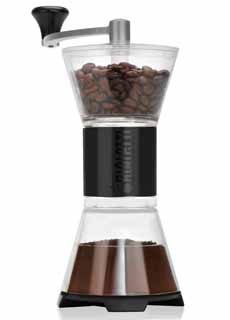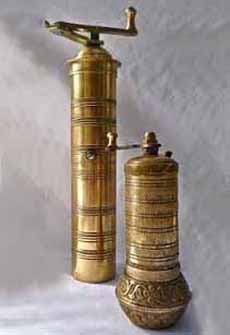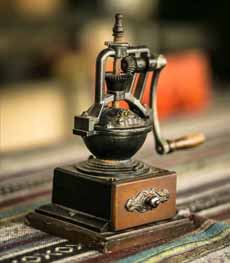PRODUCT: A New Manual Coffee Grinder
|
Everything is cyclical, even mundane household appliances like the coffee grinder. In centuries past, coffee beans were ground manually. Depending on your age, your great-grandmother ground beans in a rectangular wood or metal mill (or combination) But technology marches on: first to pre-ground coffee from supermarket brands, and then, by having your beans freshly ground at the market. By the early 1970s, the movement to buying premium beans from different terroirs around the world had begun. Shops sprang up* that sold only beans. A cup of coffee was no longer just a cup of coffee. The first electric grinder was invented in 1930, but was cumbersome and shortly discontinued. In the 1950s and 1960s, a new generation of engineers took up the challenge [source]. Slowly, they made their way across Europe, and then across the pond. By the 1980s, most households that ground their beans at home had moved on to the new, small electric grinders that ground the beans with stainless steel blades. The result was quicker ground coffee with little or no no effort. But purists complained that the friction and waste heat from the motor impacted the flavor. Some of them stuck with the manual mill and ceramic burr, which has never gone out of style. And commercial use grinders use only ceramic burrs, never metal blades. There’s more coffee grinder history below. But since everything old is new again, we’d like to present old-school grinding technology with a new-school upgrade. The Bialetti Manual Coffee Grinder (photo #1) incorporates an easy-to-adjust ceramic burr grinder designed to utilize less effort, while creating more output (46%-165% depending on the coarseness of the grind). A conical ceramic burr grinder crushes whole coffee beans into the desired coarseness, achieved with an easy-to-adjust wheel. If you’re a coffee purist—or you need to buy a gift for one—Bialetti’s Manual Coffee Grinder is available at Target stores nationwide for an MSRP of $39.99; and at Amazon for $35.57. COFFEE GRINDER HISTORY In Ethiopia, people have been consuming coffee since around 800 C.E. Today, almost half of Ethiopians the people work in the trade; most coffee grown by small farmers. The legend has that around 800 C.E., an Ethiopian goatherd, Kaldi, noticed his goats dancing with energy after nibbling the red fruit from plants they found on the slopes where he took them to graze. |
 [1] The new manual Bialetti coffee grinder (photo Bialetti).
[2] A Turkish coffee grinder (photo Turkish Coffee World).
|
|
|
We don’t know if there was a Kaldi; but someone first gathered the beans and brought them back to his village, where the people were equally enthusiastic. A trade in coffee beans began and spread throughout Ethiopia. Eating The Coffee Beans The beans—actually they’re cherries with the beans inside—were first chewed for energy. Some time later, when monks got hold of beans, they began experimenting with them, first creating a coffee-derived wine. In fact, the word coffee derives from the Arabic qahwah, a type of wine, which became kahve in Turkish, then koffie in Dutch. “Coffee” entered the English language in 1582, via Dutch. Long before there was anything we’d recognize as a cup of hot coffee, Ethiopians would crush up the fresh berries and wrap them with fat, possibly as an energy food. The cherry fruit was eaten fresh or dried; but while looking for other uses, the seeds (what we know as the coffee beans) were pulverized in a mortar and pestle of stone or wood, then cooked or roasted. By the 14th century, coffee beans reached the city of Harrar, the center of trade for Ethiopia. From there it traveled to Mocca, the trading port of Yemen in the 14th century, then up through the Ottoman Empire and on to Europe. In the 17th an 18th centuries, Dutch, French and British traders introduced coffee throughout the world. The First Coffee Grinders The first grinding technique for coffee comprised pulverizing the beans with a mortar and pestle made of stone or wood. The mill itself is much older than the coffee trade. It was developed by the Greeks around 1350 B.C.E., to crush a substance (grains, e.g.) down into a fine powder. It took a while, but he first spice grinder was invented in the 15th century in Persia or Turkey. Like a tall, slender brass pepper mill, it also was used to grind coffee beans [source]. Take a look at our: ________________ *If coffee connoisseurs were lucky, they lived in a town with a specialty coffee shop, with loose beans and packaged coffee from around the world. We were lucky: We lived in New York City, which had McNulty’s Tea & Coffee, established in 1895. It’s still located at 109 Christopher Street in the West Village (and still not open on Sundays).
|
||

